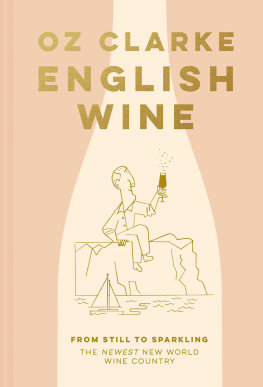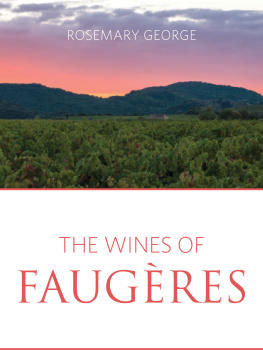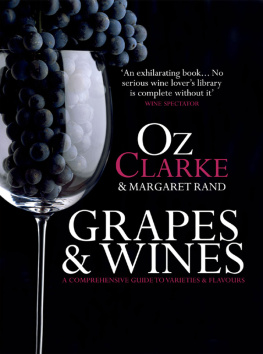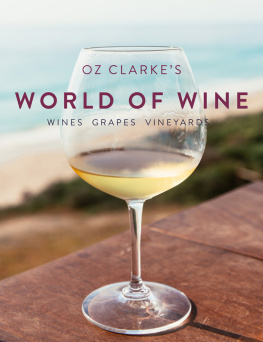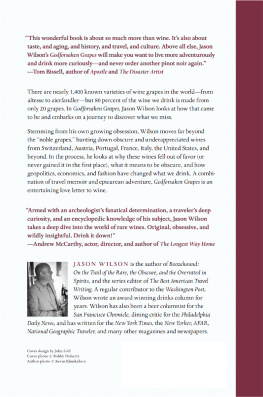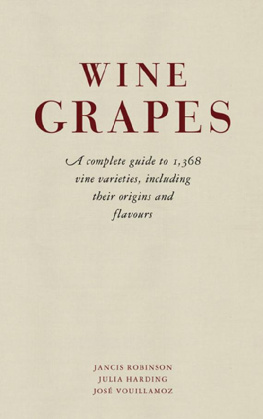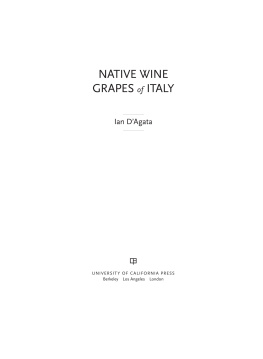GRAPES & WINES



This edition and eBook first published in the
United Kingdom in 2015 by Pavilion
1 Gower Street
London WC1E 6HD
Copyright Pavilion Books Company Limited 2001, 2003, 2007, 2008, 2015
Text copyright Oz Clarke and Margaret Rand 2001, 2003, 2007, 2008, 2015
Maps and artwork copyright Pavilion Books Company Limited 2001, 2003, 2007, 2008, 2015
All rights reserved. No part of this publication may be copied, displayed, extracted, reproduced, utilised, stored in a retrieval system or transmitted in any form or by any means, electronic, mechanical or otherwise, including but not limited to photocopying, recording or scanning without the prior written permission of the publishers.
eISBN: 978-1-909815-52-0
Paintings Lizzie Riches
Lizzie Riches is represented by
The Portal Gallery, London
Photography Cephas Picture Library/principal photographer Mick Rock, unless othewise stated
This book can be ordered direct from the publishers at www.pavilionbooks.com
For wine recommendations, special offers and news on Ozs upcoming books and events, visit www.ozclarke.com and sign up to the Oz Clarke newsletter.
Follow Oz on Twitter@OzClarke

CONTENTS
Special Features
Classic Grapes |

| 
| 
|

| 
| 
|

| 
| 
|

| 
| 
|

| 
| 
|

| 
|
INTRODUCTION

Chardonnay and Pinot Noir are just about two of the most famous classic grape varieties in the world. Both hail from Burgundy and are responsible for two of the worlds most magical wine styles Pinot Noir for haunting sensuous reds and Chardonnay for stunningly rich, honeyed, nutty, oatmealy whites. Yet isnt it strange that neither red or white Burgundy trumpets the grape names on the label?
So what is a grape, then? Well, its juice and flesh, obviously. Its skin, obviously. Its pips, and I suppose it could be the stalks as well. And then what? And then everything, thats what.
If we have any interest in wine and in flavours, we have to be interested in the grape variety itself. If we have any interest in how a wine matures and changes with age, we have to know about the potential of the particular grape. If we care about the style of a wine, whether it should be sweet or dry, fizzy or fortified or still, each different grape varietys peculiar talents will be of prime importance. Do we like the flavour of oak barrel aging in our wine? Some grapes take to oak, again some dont its vital to know which ones love the kiss of oak and which ones loathe its hot embrace. And are we fascinated by how completely different wines taste when they come from different countries and from different regions within those countries? Without the consistent character of each different grape variety to use as a measuring point, mere comparison of place would be meaningless. However far we delve into all the things that influence the flavours of our wine, it all comes back to the grape.
I mean, think about it. I give you a glass of pale golden green wine. Its got a wonderful pungent scent of gooseberry and passion fruit and lime. You taste it and the acidity crackles against your teeth, the exhilarating attack of citrus fruit scours your palate clean and makes your mouth drool with desire for food. Who made the wine? No idea. Where does it come from? It could be the Loire Valley in France. But it could also be South Africa or Chile, it could be Spain or northern Italy. And it could certainly be New Zealand. So. The four corners of the earth, really. But the grape variety? When the wine smells and tastes like that, you know it is Sauvignon Blanc. The unique, brilliantly recognizable character of the wine is down to the grape variety Sauvignon Blanc above all else. It is refined by the relative talent of the men and women who grow the grape and vinify the wine. It is modified or intensified by the local conditions under which it grows. But the core of the flavour comes from the grape.
Now, Sauvignon Blanc is a very dramatic grape. But so is Viognier with its powerful scent of apricot and mayblossom. So is Gewrztraminer with its explosion of musky rose petals and lychees. So is Muscat with its overpowering aroma of hothouse grapes. Riesling is more subtle, but the unmistakeable balance of high acidity with floral notes and citrus fruit is unique to the grape. Chardonnays nutty, oatmealy ripeness is created with the help of oak barrel aging, but no other grape achieves quite that taste, however similarly you treat it, wherever it is grown.
Red wine grapes are frequently less outspoken, and just at present the obsession with overzealous use of new oak to age wines is spoiling the thrilling individuality of many grapes flavours but good varieties still shine through. Tannic sturdiness and blackcurrant fruit mark out Cabernet Sauvignon in a way no other grape can replicate. The ethereal scent and strawberry/cherry fruit of Pinot Noir, the damson fruit and violet perfume of Malbec, the sour cherry and herbal rasp of Sangiovese, the brilliant chocolate and smoky black plum blast of Shiraz all of these experiences and many more are above all else due to the particular characteristics of the grape variety.
Next page




